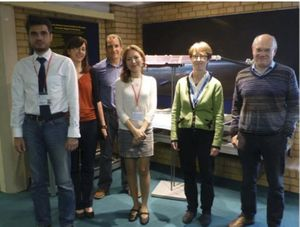OR/15/034 Science
| Alan W P Thomson (editor), Ciarán Beggan, Ellen Clarke, Simon Flower, Brian Hamilton, Gemma Kelly, Sarah Reay, Tony Swan, Alan Thomson, Chris Turbitt (contributors). 2015. Geomagnetism review 2014. British Geological Survey Internal Report, OR/15/034. |
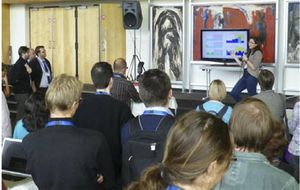
Space Weather and ESWW11
There were several advances in space weather research and applications at BGS in 2014 and the results were presented at the 11th European Space Weather Week (ESWW11), held in Liège, Belgium in November. ESWW11 was well attended with over 400 participants taking part in 14 scientific sessions and 20 splinter meetings.
The Geomagnetism team had a strong presence at the 11th European Space Weather Week (ESWW11), with two electronic-posters, one paper poster and an invited talk (Ellen Clarke). Members of the team also contributed to two further posters and presented in the ‘Ground Effects Topical Group’ splinter session.
The forecasting team were also invited to take part in a significant new ESWW initiative this year and present our ‘Live Space Weather Forecast’ during the week. The live forecast was presented by a different forecasting agency each day, reviewing space weather conditions for the previous 24 hours, and forecasting activity levels for the next 24 hours.
In the next four sub-sections we summarise the space weather research and other activities that we presented at ESWW11.
Extremes in worldwide geomagnetic activity Geomagnetic storms pose a hazard to many modern technologies.
Therefore understanding how severe such storms can be is important to a wide range of space weather data and forecast end- users. Extreme value statistical (EVS) methods were applied to a global set of geomagnetic observatory data to determine the one in 100 and one in 200 year extreme values in the North, East and horizontal magnetic field strengths and their time rates-of-change.
Data from 22 worldwide observatories were analysed, carefully chosen to provide a good geographical spread and long duration time series. The data were carefully quality controlled to produce a time series of residuals, with respect to quiet-time levels. The EVS technique was then applied to each observatory data set.
We found that the estimated largest return values were found for observatories between approximately 55° and 70° geomagnetic latitude, supporting an earlier study of European data only. And, as a particular example, the largest 100 year return level in the East component of the field was found at Fort Churchill observatory (Canada), at 5400nT.
Improving operational geomagnetic index forecasting
Geomagnetic indices provide a useful parameterisation of storm-time magnetic conditions. Indices are also required by a variety of space weather models and end- users. Currently we produce forecasts of the 3-hourly ap index, estimated using linear regression techniques. However machine learning algorithms are now being investigated, to improve the way we forecast geomagnetic activity, for example by allowing us to include as many input data types as possible.
Many of the machine learning models we have tested so far show an improvement compared to our existing forecast algorithm. In particular machine learning models appear to be better at forecasting, i.e. anticipating, magnetic storms, which is of most importance for evaluating the risk to technology.
The accuracy of extrapolated magnetic observatory measurements for MWD in the Arctic
The drilling of many extended-reach oil wells is helped by using the geomagnetic field as a reference. External field disturbances, caused by space weather, can reduce the accuracy of this reference and render it less helpful for drill guidance. External field activity can perturb the overall measured magnetic field direction by several degrees during periods of disturbed space weather. At high latitudes such perturbations can occur even during periods of relatively quiet space weather.
At BGS we use real-time data from a nearby magnetic observatory to correct for any influence of the external field and bring the accuracy of the reference field to within industry acceptable limits.
However the ‘corrective power’ of the real-time data depends on many factors including: distance to the drill site, latitude and the dynamics of the external field. For instance, as drill site-observatory distance increases, a point will be reached where the error in mapping between the two locations will become equal to the effect of the external field.
We are therefore currently studying pairs of high-latitude magnetometer stations; comparing their data streams to quantify each observatory’s corrective power see (Applications).
Mapping the aurora using social media
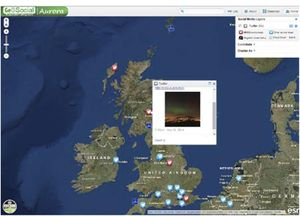
The BGS has developed a new application to display the locations of aurora sightings across the UK and beyond, using data obtained from social media.
The BGS GeoSocial web site (www.bgs.ac.uk/geosocial) shows a map that displays data from the UK geomagnetic observatories, as well as cloud cover information (using data provided by the Met Office). Twitter users can submit sightings that are then displayed on the map using the #BGSaurora hashtag. Indirect tweets related to the topic (e.g. #aurora) are also shown.
The motivation for this development has been twofold: 1) to engage the public, and help inform them where and when the aurora is visible, and 2) to gather new data potentially useful for scientific analysis.
Global modelling: WMM2015 and IGRF-12
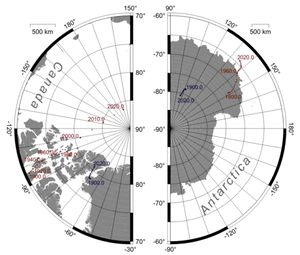
Every five years the BGS, in conjunction with the National Oceanic and Atmospheric Administration in the United States, issues an update of the World Magnetic Model (WMM). The WMM was revised in 2014 to provide a model of the Earth’s main magnetic field at 2015.0 and a prediction of the change of the field over the five years to 2020.0. BGS also contributed to the International Geomagnetic Reference Field (IGRF) model, which was also revised this year. The IGRF is a similar reference magnetic field model that can also be used up to 2020. The IGRF is developed collaboratively by various research institutes around the world.
World magnetic model
The World Magnetic Model (WMM) is a mathematical model of the Earth’s main (i.e. core-generated) magnetic field, updated every five years. It is developed together with the National Oceanic and Atmospheric Administration (NOAA) in the USA and is intended primarily for use in navigation systems for the UK and US military.
The WMM2015 model describes the main field of the Earth at 2015.0 up to degree and order 12, which approximates to a length scale of around 3300 km at the Earth’s surface. As the main magnetic field changes continuously, a prediction of the change over the subsequent five years to is also included.
Data for the WMM comes from both the global ground-based magnetic observatory network and satellite surveys such as the current ESA Swarm mission. The WMM consists of a set of coefficients describing the spatial features of the magnetic field and how they change with time, coded in software and used to compute the value of the magnetic field at any position on or above the Earth’s surface. In addition, BGS offers a free online calculator for use by the general public.
In the past decade, the WMM has become popular in smartphone mapping and navigation applications as a means of making declination corrections. The declination angle at the phone’s location is used to convert the digital compass measurements of magnetic north (made by the phone) into true north. While the correction is currently small in the UK (less than 2°), it can be quite large in some parts of the world, for example in California the declination angle is over 12°.
For the WMM2015 release, a significant amount of research was carried out to understand the average uncertainty or error associated with values produced by the model. As well as the main field, there are other sources such as the external field and the crustal field. As these other sources are not captured by WMM2015, we conducted a study to describe the uncertainty arising from not including them in the model. Our conclusion was that the average global uncertainties were smaller than the accuracy required by the US and UK military.
IGRF-12
The International Geomagnetic Reference Field (IGRF) model, generation 12, is a collaborative main field model also released and updated on a quinquennial basis.
It consists of what is known as a ‘definitive model’ up to 2010.0, a model for 2015.0 and prediction of field change for the five years to 2020.0. The IGRF-12 model describes the magnetic field up to degree and order 13, different to the WMM, with the predictive part covering variations only up to degree and order eight.
Nine research institutes submitted candidate models to the IAGA IGRF-12 task force for consideration, including the BGS. Most models were similar, mainly due to the use of similar satellite and observatory data sets and data preparation techniques. The final IGRF-12 models were then generated from these candidates using ‘Huber weighting’ in space to combine the models in an optimal manner.
The IGRF-12 is approved by IAGA as an official standard model for scientific applications. A special issue of Earth Planets and Space will be published in 2015 describing the derivation of each candidate and the comparisons made between models.

ESA Swarm mission
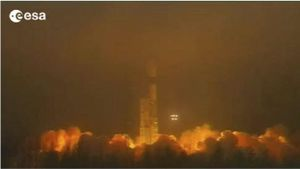
ESA’s Swarm mission was launched in November 2013. Since then, this three satellite constellation has been sending back an abundance of high quality vector measurements of the Earth’s magnetic field over all parts of the globe. Here we take a look at the Swarm data and present two projects that have benefited greatly from this mission.
Swarm data
Since its launch Swarm has already accumulated 10s of millions of measurements. The mission is expected to last a minimum of five years and therefore promises much more data. The Swarm magnetic field data intended for most scientific applications is the ‘Level 1b’ (low rate) product, which provides vector and scalar samples of the magnetic field every second for each of the three satellites.
Two of the satellites fly in close proximity in near identical orbits at ~470 km altitude to allow measurements of the field gradient, whilst the third flies at ~520 km altitude and in an orbit that changes over time at a different rate to the other two. The map (right) shows all satellite tracks for a single day. Sixteen orbits per day give near global geographic coverage, with the gaps between tracks being filled in on subsequent days, through satellite drift. In local-time (i.e. relative to direction of Sun) coverage is slower to accumulate, completing full global coverage about three times per year for each satellite.
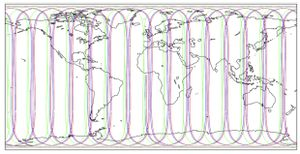
The orbits are almost exactly North-South but a slight inclination means data within 2° of the North- and South-Poles are not sampled.
With three satellites flying simultaneously at different altitudes and local times, the Swarm mission provides the most comprehensive satellite data coverage ever achieved. Such an abundance of high quality data is a boon for science and field modelling. BGS was one of the first institutions to make use of these data and 17 our science has already benefited from them. Two examples are given below.
Rapid magnetospheric model
ESA commissioned BGS to develop a rapidly-delivered, per-orbit, magnetospheric model based on Swarm data. This model describes the large-scale magnetospheric field, primarily from the ring current, orbit by orbit.
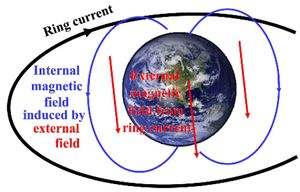
This model became operational in September 2014 and has been producing daily updates ever since. The processor generates the new day’s model coefficients within one hour of receiving the Swarm data and is capable of near real-time delivery, if required by ESA in the future.
The Figure below shows the magnetic field at the Earth’s surface from the dominant part of the external component at the Earth’s surface. Large deviations indicate disturbed field/enhanced ring current.
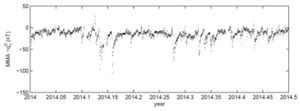
We find the Swarm magnetospheric model is less susceptible to baseline jumps than the real-time Dst, an equivalent widely-used index based on low-latitude magnetic observatory data.
Global field-modelling
Global geomagnetic field models require global data coverage. Observatories provide excellent time resolution, which is very useful for estimating the time variation of the field, but their spatial density is low in remote and ocean areas. Satellite data therefore provides the required high spatial-resolution coverage.
Since the end of the CHAMP satellite mission in 2010, there have been relatively few data satellite available for global modelling: intermittent scalar data from the venerable Ørsted satellite have been necessarily supplemented by the reliable observatories’ time-series.
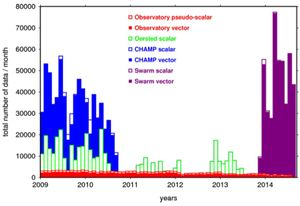
This relative dearth of data makes the job of estimating the field in that period, and into the future, more difficult. However from November 2013, there has been a huge surge in available vector satellite data (see Figure above). The data rate now available exceeds anything previously. This has allowed BGS to generate high quality main field and secular variation models for the BGGM2014, IGRF-12 and WMM2015.
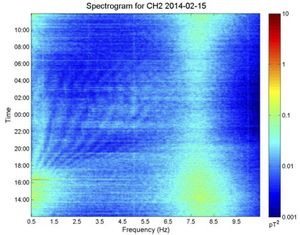
Automatic detection of ionospheric Alfvén resonances
BGS operates two high frequency induction coil magnetometers at the Eskdalemuir observatory. These coils record magnetic field variations at higher frequencies than our standard observatory instruments. We have used the induction coils to study a particular physical phenomenon called ionospheric Alfvén resonances (IAR). A new method has been developed to automatically find and classify certain patterns in the IAR data and we have examined some of the seasonal and cyclical trends in the data.
Induction coils measure small and very rapid changes of the magnetic field. A set of induction coils at the Eskdalemuir observatory record magnetic field changes over a frequency range of 0.1—50 Hz, which typically encompasses geophysical wave phenomena related to the conductive parts of the upper atmosphere (generally referred to as the ionosphere).
The ionosphere acts as a partial ‘barrier’ which electromagnetic (EM) waves can bounce off, become trapped in and resonate back and forwards for short periods. Schumann resonances (EM waves trapped between the Earth’s surface and the bottom of the ionosphere) and Ionospheric Alfvén Resonances (EM waves travelling along magnetic field lines trapped between the bottom and the top of the ionosphere) are two such examples. However, to properly observe these phenomena, we have to look in the frequency domain of the measured magnetic time-series.
The IAR are known as spectral resonance structures (SRS) and are visible as a series of fringes in spectrograms of the magnetic field rate of change (see Figure above). There are several parameters that can be computed from the SRS to give information about the ionosphere itself. For example, the frequency interval (∆f) between spectral lines can be used to determine the length interval of the ionospheric cavity and the density of the electrically charged particles in the ionosphere. To compute this manually is onerous, so a method to automatically detect the SRS fringes and the relevant parameters has been developed.
The method can be divided into two parts. The first part uses signal processing techniques to identify the SRS peaks within each line of the spectrogram while the second part involves the use of image processing to link the individual peaks together and discern the continuous fringe patterns. The method is fully automatic once some thresholds have been set by manual inspection. As with any method, there is a trade-off to be made between detection of signal and sensitivity to noise. The Figure below shows results for the 15/16th March 2014. The black lines denote the detected SRS.
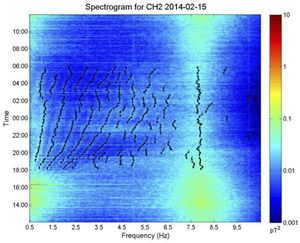
Once the algorithm has automatically detected the SRS, we are interested in extracting useful parameters such as the number of fringes, the frequencies they occur at and the width between the peaks (∆f).
The histogram (Figure below) shows the results from processing approximately eighteen months of induction coil data (Sep 2012-Feb 2014). The most common number of fringes is 10, which occur across the frequency range 1-6 Hz with an average ∆f of 0.5 Hz.
In addition to these average trends, there are also clear seasonal trends in the data when examined month by month. For example, the average value of ∆f is largest in Northern Hemisphere winter and smallest around the equinoxes. There are also longer trends in the data related to the solar cycle and the influence of the Sun’s magnetic field on the ionosphere. In future, with a longer dataset, we will be able to extract all of these effects.
The parameters derived from this study match the findings from other published research, giving us confidence that the data from the induction coils are of suitable scientific quality. The detection method can also be applied to other phenomena of interest in the induction coil data such as automated detection of Schumann resonance properties or of magnetospheric pulsations.
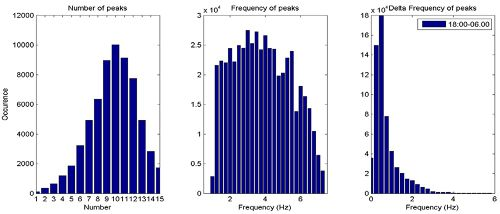
Student and visitor activities
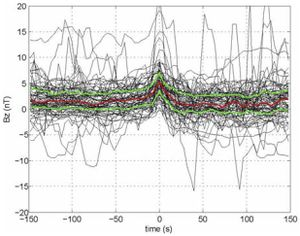
During 2014 BGS were involved, with the University of Edinburgh in conceiving and supervising several undergraduate projects concerning geomagnetism. BGS Geomagnetism also undertook PhD supervision and hosted a number of visitors from the UK and abroad.
Postgraduate students
In March 2014, BGS agreed to advise Sean Blake, a new PhD student at Trinity College, Dublin, supervised by Prof. Peter Gallagher in the Astrophysics Research Group. Sean is investigating the effects of Geomagnetically Induced Currents in the Eirgrid transmission network in Ireland, as well as other space weather effects. He produced posters for the European Space Weather Week and American Geophysical Union conferences in 2014.

Undergraduate students
We helped devise and supervise five research projects by 4th year undergraduate students at the University of Edinburgh School of Geosciences during 2014.
Jenny Johnson investigated the properties of polarisation of electromagnetic (EM) waves from lightning strikes around the world, as recorded in the Eskdalemuir induction coil magnetometers. The project focused on diurnal and seasonal variations in the splitting modes of EM waves as they resonate around the globe. The research was very thorough and received a high mark from the examiners.
Nina Kahr undertook a three month research project to study data from the ESA Cluster satellite mission. Nina made a survey of tail-ward propagating dipolarisation fronts, events occurring in the Earth’s magnetotail and related to the magnetic reconnection that drives geomagnetic storms. She surveyed eight years of Cluster magnetometer and ion- detector data for events propagating away from Earth (see Figure above). These are thought to be ‘mirror events’ to the storm-triggering flows. She performed the first multi-spacecraft analysis of tail-ward propagating dipolarisation fronts and tested two hypotheses: (1) that the occurrence of tail-ward dipolarisation fronts does indeed mirror that of Earthward propagating ones, and (2) that the tail-ward flows are larger in scale than the Earthward events observed in the same region.
Aidan Hunter studied the relationship between coronal mass ejections (CMEs) and geomagnetic storms. Aidan calculated the Direction Parameter (DP) — a measure of how symmetrical a halo CME is around the Sun — for 53 full halo CMEs which were associated with X-class flares. He then assessed how effective the Direction Parameter is as a predictor of geomagnetic activity, and found a high correlation between DP and the Kp index. This work will feed into space weather forecast operations at BGS.
Moses Mwakyanjala (below) spent six weeks as a summer project student developing code and software for a Raspberry Pi based magnetometer system. Moses developed the outline for a website implementation of a network of magnetometers and showed how to deliver data in real-time in a web-service accessible to the public.
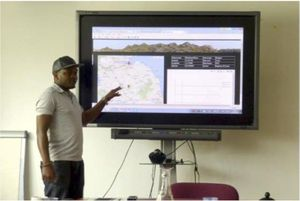
Kittiphon Boonma examined the occurrences of magnetospheric and ionospheric pulsations in Eskdalemuir induction coil data, showing that the occurrence of such features compares well with those found by other researchers.
Visitors
Adhytia Putra is a photojournalist who spent some time at the BGS in May and June. He produced an experimental documentary work called ‘Natural Surveillance’ documenting the magnetic observatories at Eskdalemuir and Hartland and our work back at the office in Edinburgh. You can see Adhytia’s finished work at: http://naturalsurveillance.weebly.com/
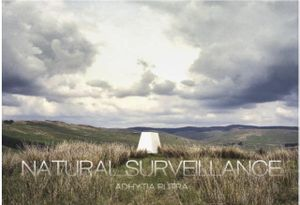
Rachel Bailey from ZAMG (Austria) visited BGS in June. She gave a presentation on Conrad Observatory at a team seminar and provided insight into the Austrian Schools magnetometer project she manages. Rachel is now leading a PhD project to study GIC in Austria, on which BGS are advising.
